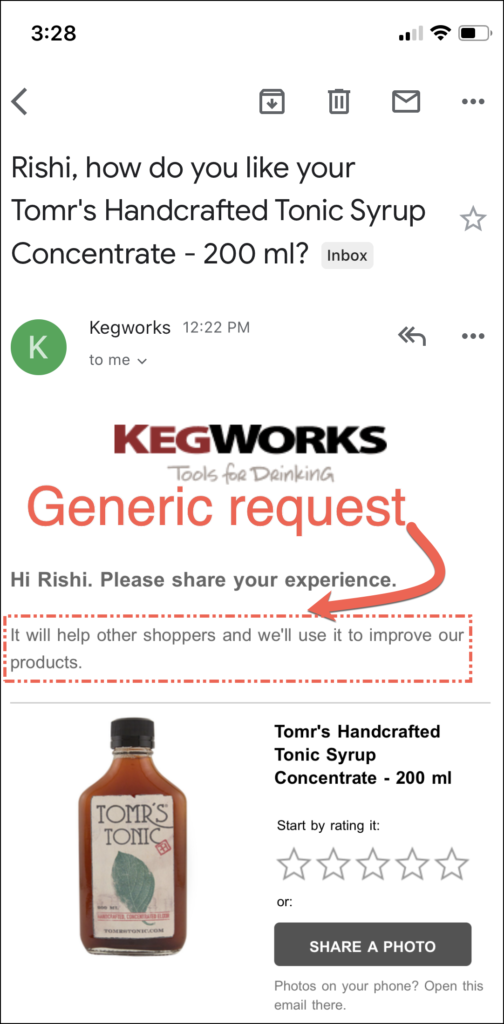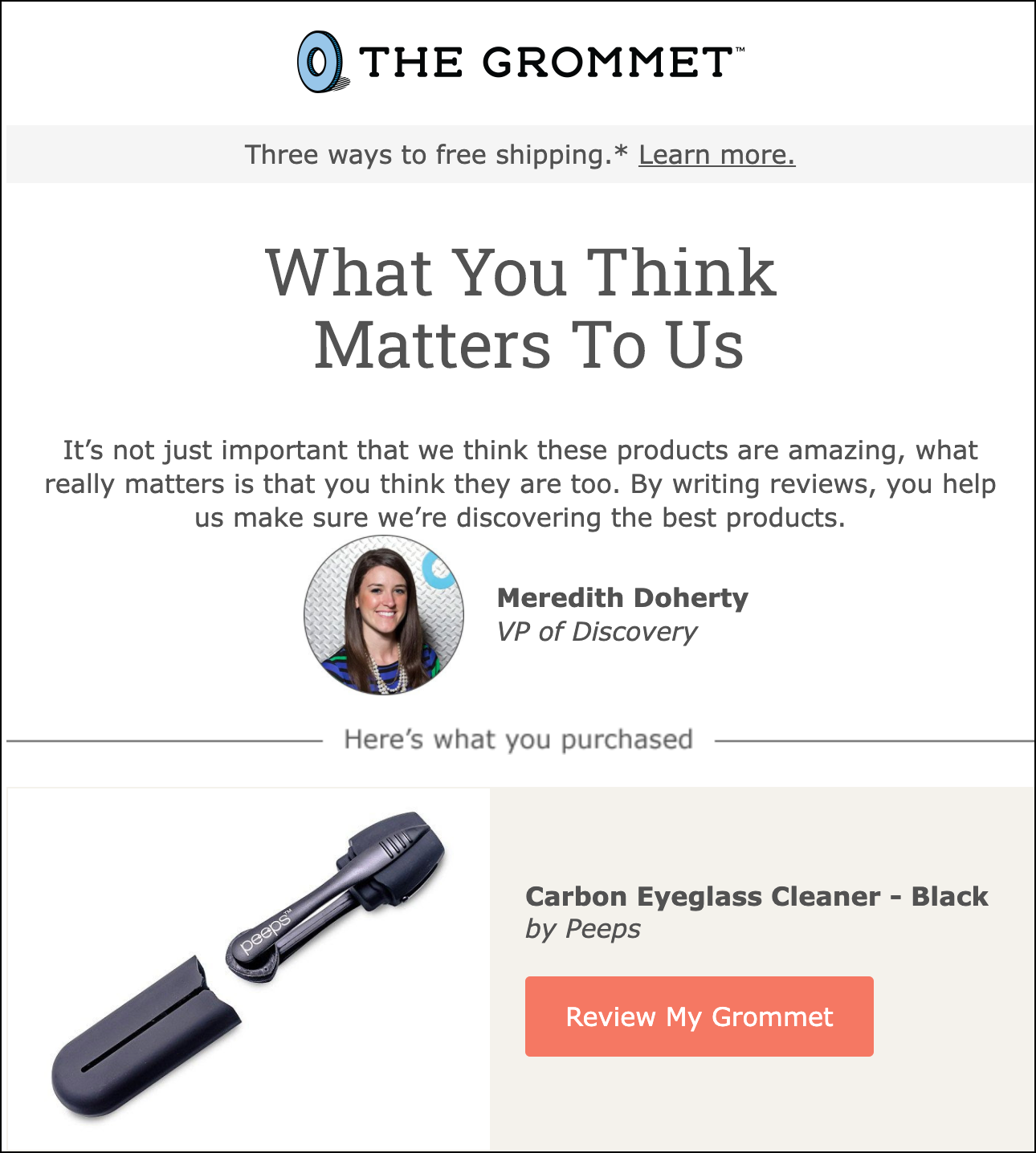Blog
Collecting Product Reviews
Importance of collecting better product reviews
Reviews serve 2 purposes:
- They show social proof. A first-time buyer would be greatly influenced by a review that starts off with, “I’m a first-time buyer, let me tell you about my experience … ” and a skeptical shopper would be influenced by a review from a fellow skeptic.
- They help address specific questions specific buyers have.
Review stats
Collecting more and better product reviews creates a flywheel effect. The more reviews you have higher your conversion rates. Some interesting stats:
- According to Reevoo stats, 50 or more reviews per product can mean a 4.6% increase in conversion rates.
- Product reviews also reduce return rates. Products with 50+ reviews have a return rate that is half that of those with less than 5 reviews. (Bazaarvoice.com research).
The problem with generic review collection emails
Marketers love automation. As a result, when a shopper buys we send them a generic email like this all too often (notice red arrow we added in the screenshot below):

This email explains why review submission rates are low. In the email above, the pitch the marketer is making for their email is this: It will help shoppers and we’ll use it to improve our products.
This isn’t a compelling pitch. Yotpo — which is an industry-leading tool for collecting product reviews — has a response rate of 8.1%. Assuming your review response rate is in that range this means that for every 100 buyers contacted, only 8 write a product review. That’s kind of crappy, to put it bluntly.
Not only does sending a generic email guarantee a low response rate but even if someone does respond, it’ll be a low-quality/low-value response. Something like this:

How to craft better product review emails (with examples)
Example 1
Let’s revisit the Tomr’s Handcrafted Tonic Syrup Concentrate example from KegWorks.com.
What if the design of our review request email was the same as the screenshot above but with this personalized copy:
Hi Rishi,
It’s been 3 weeks and everyone here at KegWorks is hoping you’ve had a chance to try your new tonic water with a few gin cocktails. We’re dying to know:
– Have you ever used tonic water made from cinchona bark before?
– Let us know the recipe for your gin cocktail. We’d love to feature it on our product page.
– Have you tried it with Campari? You should!
– What flavor profiles were most clear when you tasted it?
We’d love to know your experience.
I’m pretty positive this will double response rates.
Sure, it’s a little more work. For reference, crafting the email above took me an extra 20 minutes. But it’s a good investment.
Example 2
Heather purchases the Rambler 30 oz. Tumbler from YETI.com. On the order confirmation page, YETI could ask 4 questions:
- Are you male or female?
- Have you bought anything from us before?
- How were you keeping your beverages cold/hot before this? [multiple choices]
- Why did you choose the 30 oz. option? [multiple choices]
- Was there anything that nearly prevented you from buying from us today?
Then, after 10 days they could send an automated email that says:
Hey Heather,
We hope you’re enjoying your Rambler tumbler.
You know, 83% of our online shoppers are men, which means we don’t get too many female perspectives. We’d love to get your thoughts as a first-time buyer. Your perspective would greatly help other female shoppers.
[Write review] button.Thanks!
You can basically automate the whole backend system so the email that’s sent will change based on the answers to the 4 questions on the order confirmation page. For example, someone purchases the tumbler, he is a first-time buyer, and he is based in Arizona. This person will receive this automated email:
Hey Steve,
We hope you’re getting the most from your Rambler tumbler.
We’d love hear your thoughts about how your Rambler is holding up against the intense Arizona sun.
[Write review] button.Thanks!
The benefit of these personalized emails isn’t only in terms of the variety of reviews submitted and SEO value, it can also dramatically impact conversion rates. Let me explain. Once you’ve collected a good number of reviews you could add these links to the bottom of product description:
[Reviews from first-time female shoppers]. This would appeal to a first-time female shopper and after clicking [Reviews from first-time female shoppers], she would be shown all first-time buyer, female reviews.
[Reviews from people in your state]
[Reviews from people who ditched their current product for Rambler tumbler]
And so on…
Example 3
Let’s stick with YETI. The CAMINO CARRYALL 35 is marketed as a rugged bag. But most of the reviews don’t talk about that feature. So what can one do? Simple — send an email to people who purchased the bag in the last 6 months. Here is an example:
Subject: Camino Carryall is rugged, right?
Hi, Steve.
You’ve had your Camino Carryall for the last 6 months. We hope you’re using the heck out of it. We also hope you’ve been rough with it because ruggedness is a feature engineered into the bag.
But you know what? We have 853 reviews and only 6 talk about the ruggedness of the product. That sucks because we went through 38 prototypes just to maximize ruggedness.
If you’ve taken the bag through the paces, we would love your feedback on the ruggedness of the bag.
[review link]We need your help, Steve.
Thank you!
CEO
You don’t have to create a custom email for every product page.
Prioritize for the following scenarios:
- New products. So you can quickly start collecting quality reviews.
- Expensive products. For expensive products, collecting product reviews matters even more.
- Products that have too few reviews but sell in large quantities.
If you’re lazy
We hope you’ll use the 3 examples given above. But if you insist on continuing to use a template mass email do what The Grommet does.

I’ve seen many crappy review request emails. This one is good.
1: The copy is good.
2: It feels like a person, Meredith, is asking for my opinion.
Some interesting stats about buyer psychology of product reviews
- Up to 80% of reviews originate from follow-up emails urging shoppers to review their purchases (Power Reviews, 2017)
- 7 out of 10 customers will leave a review when asked to do so (Broadly)
Active on LinkedIn?
If you’re on LinkedIn much you can should definitely connect with me. On LinkedIn, I post ecommerce conversion ideas every day, multiple times a day.




Comments 2
I had literally never thought of sending review requests manually, such a good idea! Im going to look at doing that. Thanks,
ReplyRishi Rawat
So glad you liked it, Liz. Thanks also for joining my newsletter. I’ll be sharing all my secrets with you 🙂
Reply